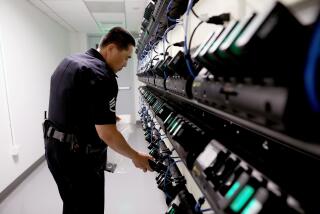Op-Ed: One way to shrink the LAPD’s budget: Cut costly and invasive big-data policing

Demonstrations over the use of police force against Black people have begun taking aim at bloated police budgets. Recent news coverage highlights the military hardware, including tanks and helicopters, riot gear and noxious gas, police have used against the protesters. Less obvious, but not necessarily less costly or dangerous, is the invisible military surveillance software in law enforcement’s arsenal.
The Los Angeles Police Department has signed a growing number of expensive, secretive contracts with private companies to design and deploy proprietary platforms to surveil civilians as they go about their everyday lives. Like the weapons and vehicles handed down to local police from the armed forces, many of these data systems were developed for military use.
Over the last seven years, I observed this while studying how the LAPD uses big data and surveillance technologies. I interviewed officers, shadowed crime analysts and rode in police cruisers to see what data-driven policing looks like in real time. It was a revelation to see how much information police officers could access with the click of a mouse.
One surveillance system the LAPD uses is designed by Palantir Technologies, the CIA-backed Silicon Valley start-up valued at $20 billion that has confidentially filed with U.S. regulators to go public. Its other clients have included the New York Police Department, the CIA, U.S. Immigration and Customs Enforcement, and JPMorgan Chase & Co.
Since 2011, the LAPD has contracted with Palantir to integrate a staggering array of personal data for surveillance and predictive purposes. The result is that the police are building a sprawling database of information populated by individuals who may not have come in direct contact with police — yet their personal information is among millions of data points that might include the model of car they drive, their traffic citations and their home addresses.
A central person of interest can draw colleagues, siblings, roommates and romantic partners into the surveillance network simply because of their perceived relationship with the primary person. And once they are in the system, these individuals can be “autotracked,” meaning officers can receive real-time alerts about their activities.
Palantir is also used to interpret data from automatic license plate readers, a dragnet surveillance tool that collects information on everyone, not just those under criminal suspicion. Palantir’s systems map the data to help police track vehicles and people across cities, enabling law enforcement to learn a driver’s typical travel patterns and identify deviations. One LAPD crime analyst showed me how he used license plate readings to deduce, for instance, that an individual who repeatedly parked a car in the same place at night was likely using it as a “honeycomb” or hideout.
Secrecy shrouds the use of these technologies. The amount police departments spend on surveillance software is largely unknown. Public records requests reveal that the LAPD paid more than $20 million to Palantir between 2009 and 2018. But Palantir is just one platform.
Officers say they are demoralized by the cuts, which will deliver a huge hit to overtime pay and hiring in the 10,000-member department, when they have worked hard to build ties with community members and are willing to risk their lives to keep people safe.
The LAPD and other agencies use dozens of platforms. Trade secrecy and nondisclosure agreements mean these private vendors can provide police cover as they circumvent public-sector transparency requirements, lowering accountability while also making big-data policing harder for scholars to study, regulators to regulate and activists to mobilize against.
In response, New York’s city council passed a bill in June requiring the NYPD to disclose which technology it uses and what data it collects. Los Angeles should follow suit.
Analytic software also can exacerbate inequalities under the veneer of objectivity. Surveillance tools such as license plate readers are deployed based on past department crime statistics, which means that “predictive policing” data systems disproportionately point to Black and brown people and neighborhoods for heavier policing and future data gathering.
Because big-data policing relies on “teaching” algorithms based on historical crime data, longstanding tendencies to overpolice minority communities become integral to what is supposed to be an objective, “data-driven” directive to surveil those people and areas. The result is a self-fulfilling statistical prophecy.
While proponents of the technology argue that these tools help police track down criminals and lower crime rates, there is scant evidence that they actually do that. In the digital age, data are a form of capital. If only the police and tech companies have access to the data and analytic software, independent evaluation of how this capital is being leveraged in law enforcement is impossible.
Data and surveillance technologies are largely missing from today’s urgent conversations about how to defund, shrink, reform or abolish the police. In this moment of national reckoning, as reformers consider the future of American policing, they cannot continue to ignore the many costs of invasive yet largely invisible big-data policing.
Sarah Brayne is an assistant professor of sociology at the University of Texas at Austin and author of the forthcoming “Predict and Surveil: Data, Discretion, and the Future of Policing.”
More to Read
A cure for the common opinion
Get thought-provoking perspectives with our weekly newsletter.
You may occasionally receive promotional content from the Los Angeles Times.







